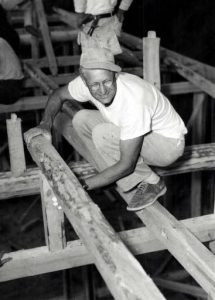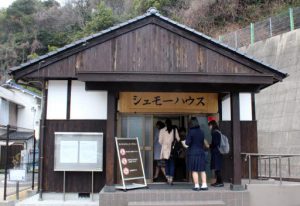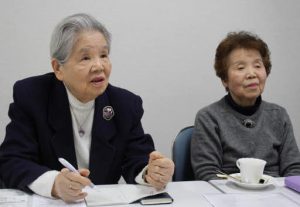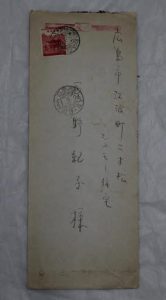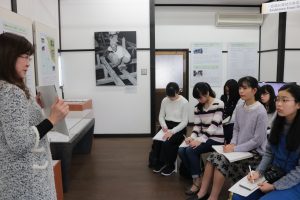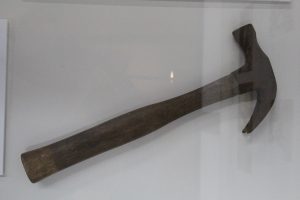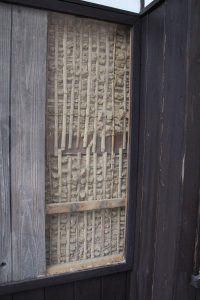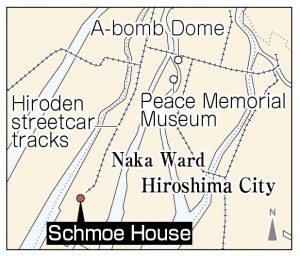Junior writers visit “Schmoe House” on 70th anniversary year of “Hiroshima Houses”
Mar. 18, 2019
Do you know Floyd Schmoe (1895-2001)? He was an American pacifist who came to Hiroshima in August 1949 to build “Hiroshima Houses” for those who had lost their homes in the A-bomb attack. This year marks the 70th anniversary since Mr. Schmoe built the first house in Hiroshima. The junior writers of the Chugoku Shimbun visited the “Schmoe House” in Naka Ward’s Eba-nihonmatsu district, the only house that still exists today. We also listened to the old memories of two sisters who once lived in one of the houses. Tracing Mr. Schmoe’s footsteps in the city, we renewed our determination to think of people who are affected by war or disaster, and help provide them with the support they need.
American helped Hiroshima citizens to reconstruct the city
Guided by Hiroko Nishimura, 61, the director of a citizens’ group called “Learning from Floyd Schmoe,” the junior writers toured the Schmoe House, which was originally built as a community center in 1951. The house reopened as an exhibition facility affiliated with the Hiroshima Peace Memorial Museum seven years ago. Last month, prior to the 70th anniversary of Mr. Schmoe’s work, the museum partially revamped its exhibition. Now on display is a card with messages from volunteers who helped build houses as well as a drawing of design plans for a house and part of the original exterior wall.
A hammer on display was used to pound nails when the houses were being constructed. Mr. Schmoe gave it to a man who took part in the housing project, who then treasured it. Looking at the hammer, we could feel Mr. Schmoe’s passion and faith to help the people of Hiroshima reconstruct the devastated city.
Mr. Schmoe was born into a farm family in the Midwestern state of Kansas. Ever since he was a child, he was taught that violence and war should be avoided at all costs. He learned about the devastating consequences of the atomic bombing of Hiroshima from the reportage Hiroshima, written by the American journalist John Hersey and published in 1946.
Thinking that the atomic bombing was a terrible sin and he must do his part, as a human being, to atone for this tragedy, Mr. Schmoe made his first visit to Japan in 1948, the year he turned 53 years old. He returned to Hiroshima the next year and built two wooden houses in Minamimachi, Minami Ward, with fellow volunteers. He collected contributions of about 4,300 dollars in the United States for the housing project.
It seems Mr. Schmoe also hoped to deepen mutual understanding and promote peace through the act of building houses. He visited Hiroshima several times from 1949 to 1953 and constructed a total of 15 houses (for 21 families) in the Eba district and Ushita-higashi (in Higashi Ward).
“Learning from Floyd Schmoe” has produced books and picture books to share Mr. Schmoe’s activities. They sometimes read the books to children at preschools. We feel that it’s very important to learn about the support Hiroshima received from people overseas as well as the damage caused by the atomic bombing. We would like to think carefully about the kind of support people need, then take action to help them.
Two sisters lived in a “Schmoe House”: “The pink-tinted roof was nice.”
Toyoko Uchiyama, 81, a resident of Hatsukaichi City, and Mieko Kotabe, 80, a resident of Higashihiroshima City, are sisters whose family once lived in one of the “Hiroshima Houses” in Eba-cho (now Eba-nihonmatsu, part of Naka Ward) since the summer of 1950. The Harano family was a family of six, including Toyoko and Mieko. They looked back fondly on the day they moved into the house, saying, “The pink-tinted roof was very nice,” and “We happily rolled around on the tatami mat floor.”
During the war, the family moved from the Kansai region to Yoshijima-hagoromomachi (now part of Naka Ward) where the sisters’ grandparents lived. However, the family lost their home in the atomic bombing of Hiroshima. The sisters’ father, Susumu, was a pastor. He was admitted to a hospital in Hiroshima, where he met Mr. Schmoe, who was visiting as a volunteer. This is how the family ended up living in the house.
“Every Sunday, my father invited neighborhood children and read a story from the Bible or sang a hymn,” Mieko said. The sisters saw Mr. Schmoe working hard during summer vacation. They said, “He seemed like a person of strong beliefs, and he was always surrounded by other people.” Susumu never failed to write “Schmoe House” in the return address of his letters so they would not forget what Mr. Schmoe had done for them.
“Schmoe House is a large gift we received after the war. It was built with donations from many Americans we don’t know. We would not be here without their kind support,” Toyoko emphasizes. The sisters have donated five envelopes on which “Schmoe House” is written in the address or return address to Hiroshima Peace Memorial Museum.
This article was written by the following junior writers: Yuno Nakashima, 13, Hitoha Katsura, 14, Yukiho Saito, 16, Kana Okino, 18, Honoka Ikeda, 18, and Naruho Matsuzaki, 18.
(Originally published on March 18, 2019)
American helped Hiroshima citizens to reconstruct the city
Guided by Hiroko Nishimura, 61, the director of a citizens’ group called “Learning from Floyd Schmoe,” the junior writers toured the Schmoe House, which was originally built as a community center in 1951. The house reopened as an exhibition facility affiliated with the Hiroshima Peace Memorial Museum seven years ago. Last month, prior to the 70th anniversary of Mr. Schmoe’s work, the museum partially revamped its exhibition. Now on display is a card with messages from volunteers who helped build houses as well as a drawing of design plans for a house and part of the original exterior wall.
A hammer on display was used to pound nails when the houses were being constructed. Mr. Schmoe gave it to a man who took part in the housing project, who then treasured it. Looking at the hammer, we could feel Mr. Schmoe’s passion and faith to help the people of Hiroshima reconstruct the devastated city.
Mr. Schmoe was born into a farm family in the Midwestern state of Kansas. Ever since he was a child, he was taught that violence and war should be avoided at all costs. He learned about the devastating consequences of the atomic bombing of Hiroshima from the reportage Hiroshima, written by the American journalist John Hersey and published in 1946.
Thinking that the atomic bombing was a terrible sin and he must do his part, as a human being, to atone for this tragedy, Mr. Schmoe made his first visit to Japan in 1948, the year he turned 53 years old. He returned to Hiroshima the next year and built two wooden houses in Minamimachi, Minami Ward, with fellow volunteers. He collected contributions of about 4,300 dollars in the United States for the housing project.
It seems Mr. Schmoe also hoped to deepen mutual understanding and promote peace through the act of building houses. He visited Hiroshima several times from 1949 to 1953 and constructed a total of 15 houses (for 21 families) in the Eba district and Ushita-higashi (in Higashi Ward).
“Learning from Floyd Schmoe” has produced books and picture books to share Mr. Schmoe’s activities. They sometimes read the books to children at preschools. We feel that it’s very important to learn about the support Hiroshima received from people overseas as well as the damage caused by the atomic bombing. We would like to think carefully about the kind of support people need, then take action to help them.
Two sisters lived in a “Schmoe House”: “The pink-tinted roof was nice.”
Toyoko Uchiyama, 81, a resident of Hatsukaichi City, and Mieko Kotabe, 80, a resident of Higashihiroshima City, are sisters whose family once lived in one of the “Hiroshima Houses” in Eba-cho (now Eba-nihonmatsu, part of Naka Ward) since the summer of 1950. The Harano family was a family of six, including Toyoko and Mieko. They looked back fondly on the day they moved into the house, saying, “The pink-tinted roof was very nice,” and “We happily rolled around on the tatami mat floor.”
During the war, the family moved from the Kansai region to Yoshijima-hagoromomachi (now part of Naka Ward) where the sisters’ grandparents lived. However, the family lost their home in the atomic bombing of Hiroshima. The sisters’ father, Susumu, was a pastor. He was admitted to a hospital in Hiroshima, where he met Mr. Schmoe, who was visiting as a volunteer. This is how the family ended up living in the house.
“Every Sunday, my father invited neighborhood children and read a story from the Bible or sang a hymn,” Mieko said. The sisters saw Mr. Schmoe working hard during summer vacation. They said, “He seemed like a person of strong beliefs, and he was always surrounded by other people.” Susumu never failed to write “Schmoe House” in the return address of his letters so they would not forget what Mr. Schmoe had done for them.
“Schmoe House is a large gift we received after the war. It was built with donations from many Americans we don’t know. We would not be here without their kind support,” Toyoko emphasizes. The sisters have donated five envelopes on which “Schmoe House” is written in the address or return address to Hiroshima Peace Memorial Museum.
This article was written by the following junior writers: Yuno Nakashima, 13, Hitoha Katsura, 14, Yukiho Saito, 16, Kana Okino, 18, Honoka Ikeda, 18, and Naruho Matsuzaki, 18.
(Originally published on March 18, 2019)

